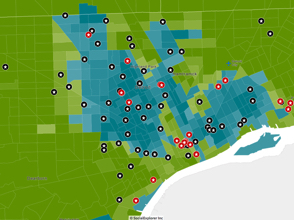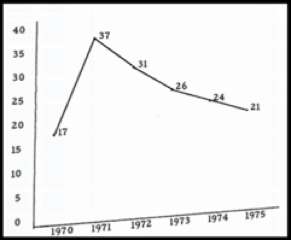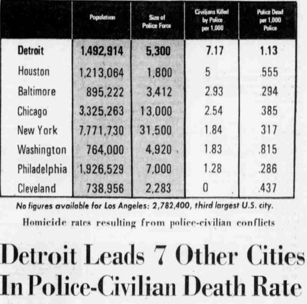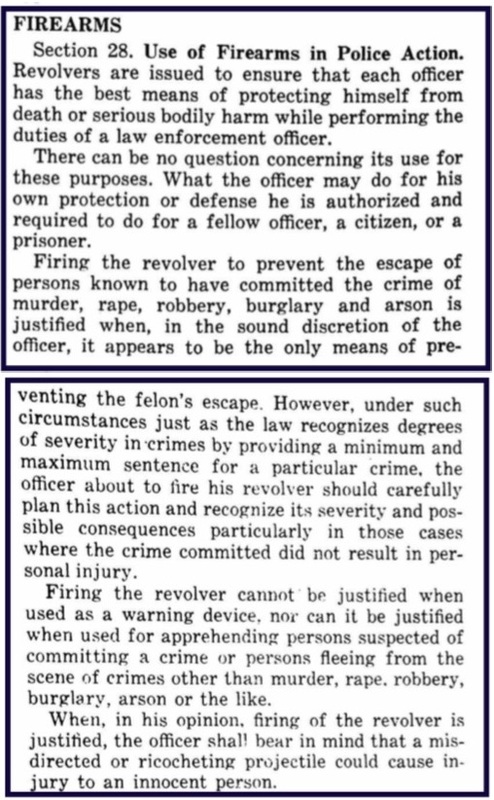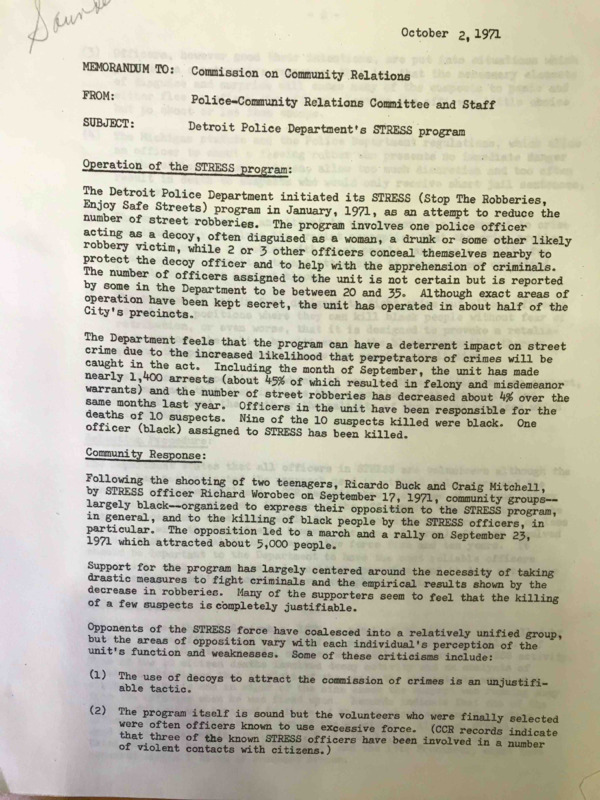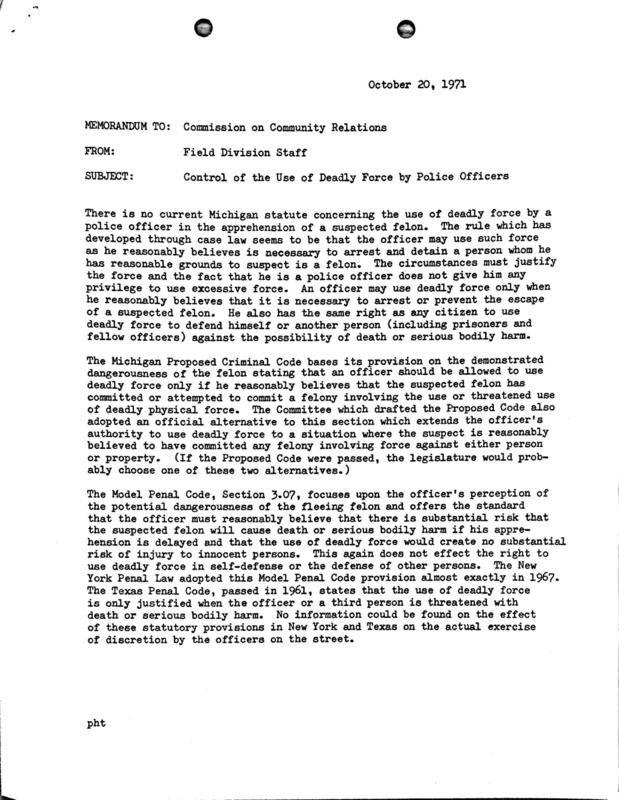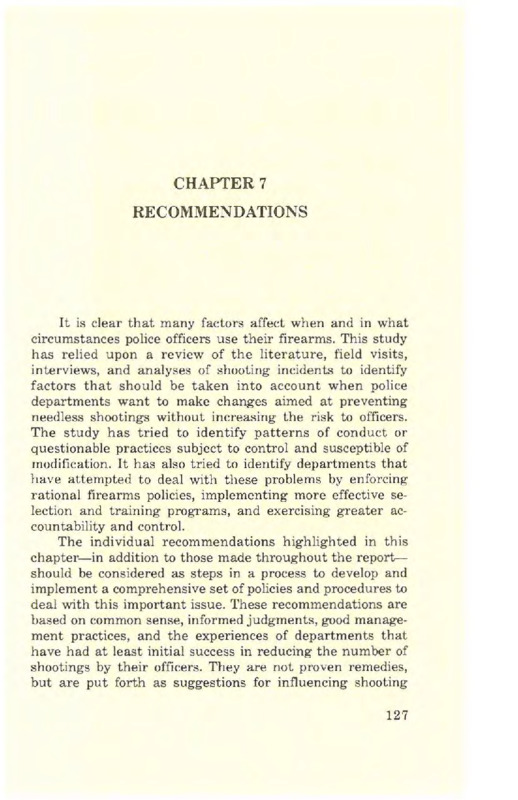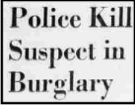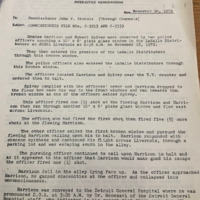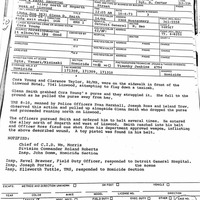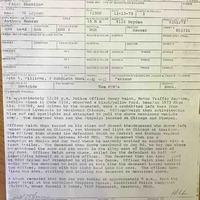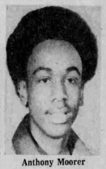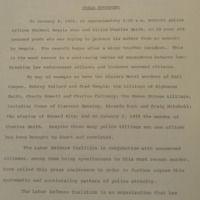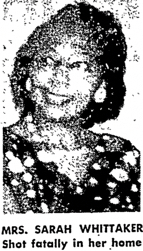Police Homicides 1971-73
The Detroit Police Department acknowledged that its on-duty officers killed 94 people between 1971 and 1973, the highest per capita rate of any large city in the nation. The DPD did not publicly disclose the number of civilians killed, and this total is available in the archives only because African American mayor Coleman Young, elected in late 1973 during the Black community's anti-STRESS mobilization, requested the information from the police department in 1975. The total of 94 people only includes the on-duty incidents acknowledged by the DPD and investigated by the Wayne County Prosecutor. The actual number is at least 108, when justified shootings by off-duty police officers are also included, and undoubtedly even higher. For just one example, DPD investigators knew about at least two homicides of drug dealers by a narcotics-involved patrol officer in 1972 but did not officially classify them as police-involved shootings.
The notorious undercover STRESS unit that killed at least 22 people between 1971 and 1973 received most of the public attention but also accounted for fewer than one-quarter of the acknowledged homicides by the DPD during this deadly period. The STRESS philosophy, however, pervaded the department patrol culture and permissive use-of-force regulations more generally, and around one-third of the non-STRESS fatal shootings involved the same pattern of firing on unarmed fleeing suspects that shaped the undercover decoy operation. The doubling of police homicides between 1970 and 1971 (chart at right) was therefore attributable not only to the 12 civilians killed that year in undercover STRESS decoy operations but also to the broader shoot-first philosophy championed by top DPD officials to deter low-level street crime and property theft through state violence and disproportionate force.
DPD officers additionally shot and wounded about 2.5 times as many people in non-fatal incidents as they killed--precise numbers are not available, and the department inconsistently enforced compliance with its "shot fired" incident reports, so this total represents an estimate by several academic studies. Extrapolating from the 94 acknowledged homicides by on-duty officers, this woiuld mean approximately 235 people shot and wounded during police operations between 1971 and 1973. The DPD also had one of the highest rates of on-duty officer deaths in the nation, although the numbers were far smaller than the civilian body count: six police officers during 1971-1972 combined (data from 1973 not available), along with three others shot and killed in off-duty incidents (two during a late-night street argument). The city further suffered from one of the nation's highest total homicide rates, with more than 600 fatalities in 1971 alone. Guns seemed to be everywhere in the early 1970s, and Detroit was a violent place.
Use of Force Policies: The Individual Officer's "Reasonable" Discretion
The deadly violence by the Detroit Police Department was a deliberate outcome of state law, DPD regulations, prosecutorial policies, and court decisions that gave extraordinary discretion to officers to fire their weapons at 'suspects' and then classified such decisions as justified if they were "reasonable" in the individual police officer's state of mind. As documented in the previous 1968-1970 section, the DPD consciously liberalized its "Use of Firearms in Police Action" policy in the wake of the 1967 Uprising, when police officers shot around 20 "looters" in circumstances that often appeared prohibited by the ban at the time on shooting someone who "simply runs away to avoid arrest." The revised "Use of Firearms in Police Action" policy (full policy in gallery below, left), which became operative on Sept. 1, 1967, and remained in effect until the mid-1970s, permitted officers to use deadly force in their "sound discretion" in order to prevent the escape of a 'fleeing felon.' The policy did not differentiate among felonies based on danger of the suspect or risk to the public and specifically added robbery and the nonviolent low-level property crime of burglary in its expansive grant of permission for officers to shoot and kill suspects. It also removed prior regulations that had barred police officers from shooting someone if they had not personally witnessed the crime and barring use of firearms "upon a person who is called upon to halt upon mere suspicion." These changes permitted police officers even to shoot unarmed people in the back, if the "known" fleeing felon did not immediately comply with a verbal command to halt and submit to arrest (or if the officer simply claimed that the suspect did not immediately comply). The new DPD policy read:
In October 1971, the Detroit Commission on Community Relations proposed a significant restriction on the DPD's use of force policies in response to the mass community protests over the STRESS decoy killings of teenagers Ricardo Buck and Craig Mitchell, who were unarmed and shot in the back as they fled from the scene of an alleged mugging. The DCCR's investigate report (gallery below, second from left) called for a revision of the "fleeing felon" policy in state law and the DPD manual to state explicitly that police officers could fire their weapons "only after the officer has exhausted other reasonable means of apprehending the suspect." The Michigan Civil Rights Commission's own investigation observed that the alternative to the current state and case law would be to restrict an officer's right to use deadly force to situations where the suspected felon had endangered either other civilians or the law enforcement officer with "use or threatened use of deadly physical force," but this did not happen (gallery below, second from right). Every civil rights group in the city also called for changes and restrictions to the DPD's discretionary use of force policy, to no avail, as Police Commissioner John Nichols and the other architects of STRESS aggressively defended the need for the threat of deadly force as a deterrent for street criminals, including low-level muggers and burglars. STRESS Patrolman Raymond Peterson, who shot and killed at least five Black males and participated in the homicides of three others in on-duty decoy operations, recalled that "whenever I shot someone, . . . the guys [at DPD headquarters] would cheer me" and the top hierarchy would reward him.
The Detroit Police Department also allowed--and even encouraged--police officers to use deadly force against juveniles, moving in the opposite direction of a number of urban police departments during the 1970s that were enacting policies banning fatal force and gunfire against minors except in self-defense. In its fall 1971 investigation of STRESS, the Detroit Commission on Community Relations observed that the DPD recognized that juveniles were disproportionately involved in low-level property crimes such as burglary, mugging by way of purse-snatching, and auto theft. The DCCR recommended that the police department ban "the shooting of perpetrators of minor street crimes that do not result in personal injuries," but the DPD again refused. The Police Foundation, a national law enforcement think tank, also conducted an analysis of deadly force policies and practices in Detroit and other cities during the early 1970s and endorsed a revised and more restrictive standard based on the actual level of immediate physical threat posed by the suspect, in order to prevent "many questionable shootings." The Police Foundation recommended that only an "immediate threat of death or serious injury" to the officer or another person should justify the use of fatal force. The Detroit Police Department instead chose to stay on a different, far more deadly, path.
Mapping 84 Police Homicides during 1971-1973
The Policing and Social Justice HistoryLab has identified 84 police homicides in the city of Detroit between 1971 and 1973, representing a large majority of the acknowledged total of 94 by on-duty officers and an estimated 108 including those by off-duty officers. It is probable that our project's ability to document a much higher percentage of these police homicides than during the previous time period of 1968-1970 reflects the greater likelihood of newspapers to report on police killings after the anti-STRESS movement politicized the issue during the protests of September 1971 (none of the 9 people killed by STRESS units before teenagers Ricardo Buck and Craig Mitchell made it into the newspapers when the incidents occurred). This data is still distorted by archival silences, comes primarily through laborious keyword searching in digital newspaper databases, and definitely does not represent the full picture.
Most of the people killed by DPD officers were African American males, although it is not possible to confirm this in a number of cases, because the Detroit Free Press and Detroit News stopped routinely reporting the race of 'criminals' and 'criminal suspects' during this period. However, based on the incident locations and other data (including an academic study estimating that around 80 percent of DPD shootings in the early 1970s involved African Americans), it is clear that the vast majority of those killed by the police were Black males, with the ages of most ranging from the late teens to early thirties. Officers from the Highland Park or Hamtramck police departments committed 3 of the documented homicides (these two small municipalities are completely surrounded by the city of Detroit), and DPD officers were responsible for the remaining 80 fatalities. All but one of the police homicides involved gunfire; the exception was a suspect in the non-fatal shooting of a white officer beaten to death by a gang of white policemen after his arrest. At least one-third of those killed were unarmed and allegedly fleeing from the scene of property crimes, and only around one-fifth of the fatalities involved armed criminals that would have clearly met the "immediate threat of death or serious injury" standard proposed by reformers; a full pattern analysis is below the map.
This interactive map locates the identified police homicides in Detroit's racial geography. The darkest blue areas are all-Black neighborhoods, and the darkest green are segregated white areas, with the shifting racial boundary in between. Note how many of the killings happened in or near the downtown business corridor, which reflected the STRESS and broader DPD policy to crack down on Black street crime in racially mixed areas, and along the racial boundaries of the expanding Black neighborhoods, evidence of a deployment policy to protect white-owned business and residences. Click on the dots to learn more about each incident, and scroll down to read about specific fatalities that are highlighted.
Map of 84 Identified Homicides by Police Officers, 1971-1973, in Detroit's Racial Geography
- Red dots = STRESS unit killings (22 total)
- Black dots = DPD killings not by STRESS (59 total identified) plus 3 in Highland Park/Hamtramck
Key Findings and Patterns
- "Justifiable Homicide" (99% of on-duty killings). The Wayne County Prosecutor, William Cahalan, found every on-duty police homicide to be "justifiable" except for one. Undercover narcotics officer Percy Key was indicted for manslaughter after shooting an unarmed man in a car without identifying himself, in front of multiple witnesses. The only other three officers prosecuted were involved in off-duty shootings. Two escalated from traffic accidents: STRESS Patrolman Raymond Peterson's ninth homicide (he was acquitted of second-degree murder) and Patrolman Michael Reggish's road rage killing of an 18-year-old neighbor after a minor incident (he also was acquitted by jury trial). The third off-duty officer was charged for killing a man who was having an affair with his wife. DPD critics denounced the "consistent pattern of prosecutorial whitewash" of unjustified police homicides and even filed a conspiracy lawsuit naming Cahalan as a defendant.
- Possible/Probable Murder or Manslaughter (29%). In the assessment of our project, at least 24 of the 84 identified police homicides either definitely or probably should have resulted in murder or manslaughter charges based on the forensic evidence, eyewitness testimony, and other suspicious patterns. This includes 14 homicides by the STRESS decoy unit and an additional 10 homicides, detailed below, by other DPD officers. (This does not count a homicide by an inebriated off-duty officer who shot a bar owner in an argument and then killed himself).
- Race (86% Black*). Almost all of the deceased whose race can be identified were African American (57 out of 66). Eight were white, and one a Latino juvenile.
- Unarmed (48%*, an additional 23% alleged/disputed). Around half of identified police homicides were of unarmed civilians or people who otherwise presented no imminent threat when killed. In an additional 23% of the total (19 incidents), whether the person killed was actually armed and posing a threat is only alleged/disputed, in our project's assessment. In a number of documented cases, police officers framed people they shot by planting knives, and so it is difficult to assess the truthfulness of many official accounts claiming that the decease was armed. A number of these disputed cases involved persons undergoing a mental health crisis, as explained below.
- Unarmed and Fleeing (38%). At least 32 of the identified fatalities involved unarmed people, mainly Black males in their teens and twenties, shot in the back while fleeing the scene of an alleged property crime or mugging. This classification includes 11 people shot and killed by STRESS decoy units that our project believes were unarmed (and that often resulted in wrongful death settlements), even though STRESS officers claimed that most of the suspects had knives. The total also includes 21 unarmed people shot and killed by non-STRESS units after alleged crimes such as purse-snatching and store or home burglary.
- "Armed and Dangerous" (23%*). 19 of the fatalities were of armed suspects who were engaged in dangerous criminal behavior such as store or home robberies and were actively threatening the lives of police officers or civilians when shot (*although in some of these cases this classification depends upon the police report's otherwise unverifiable claim that the suspect 'pointed' or 'brandished' a weapon at officers). Only about one-third of these cases involved gunfire by the suspect. (Mental health crisis situations are not included in this total, even when the person killed was armed).
- Teenagers (17%). 14 of the fatal force incidents involved teenagers, including 9 juveniles under age 18, almost all unarmed and fleeing the scene of an alleged minor crime. STRESS units accounted for 4 of the 9 fatal shootings of juveniles. Youth ages 18-19 accounted for 5 more DPD homicides.
- Home Raids (12%). 10 of the fatal shootings began with police raids of private homes, half by narcotics or vice squads. The circumstances of several were murky, indicating residents who did not realize the invaders were police officers or unverifiable police claims that the deceased 'pointed' a weapon. At least one, the killing of 57-year-old Durwood Foshee in his bedroom during the STRESS manhunt, indisputably should have been prosecuted.
- Domestic Disturbances and Mental Health Crises (20%). 10 of the killings happened during police responses to domestic disturbance calls, and 7 more involved mental health emergencies happening inside people's homes. Family members usually summoned the police during these incidents, and occasionally the person shot was armed and appeared dangerous, but in a number of cases the police fired first and the degree of threat was debatable. Critics argued that armed police officers were not trained for, and should not be responding to, mental health crisis situations.
- Off-Duty Officers (14%). 12 of the identified fatal shootings were committed by off-duty police officers, who were required to carry firearms by DPD regulation. Some involved interventions to stop armed criminals, and a couple involved officers who were drinking in bars when a fight broke out. At least three began with minor traffic accidents that the off-duty officer then escalated in a road rage scenario. The prosecutor controversially applied the same use of force standard of a police officer's "reasonable" discretion to off-duty shootings rather than treating them like any other citizen.
- Gender (95% Male). Almost all identified fatalities were of persons identified as male. The four females killed by police were all African American and included an off-duty officer who claimed to have accidentally shot his fiancee; a 16-year-old teenage girl shot in her home during a mental health emergency; a 21-year-old female shot while allegedly robbing a restaurant; and a 68-year-old widow shot inside her apartment by officers after she had called in a burglary in process. STRESS Patrolman Raymond Peterson also shot and killed a transgender sex worker in a likely premeditated murder.
- Location. The majority of police killings of African Americans took place in the downtown-midtown commercial corridor or in the racially mixed zones between white and Black neighborhoods. This is evidence of a DPD deployment policy to protect white business and residences from "street crime" associated with young Black males rather than law enforcement targeted primarily in the poorest, most racially segregated areas where almost all crime victims were African American.
23 Highlighted Fatalities of Civilians by Police Officers during 1971-1973
This section features in-depth accounts of 23 police homicides, representing around two-fifths of the non-STRESS killings during the 1971-1973 time period (all 22 STRESS homicides are covered on the separate "Remembering STRESS Victims" page). The highlighted homicides are broken down in the following three categories:
- Unarmed and fleeing civilians shot from behind by police officers
- Civilians shot and killed in suspicious circumstances that arguably should have resulted in murder prosecutions, or at least more thorough internal investigations
- Civilians killed during home invasions, often mental health crisis situations
Category 1: Ten Teenagers and Young Adults Unarmed and Fleeing
The majority of police homicides were of unarmed civilians or people otherwise presenting no serious threat when killed (in a number of these cases, specifically the STRESS-involved homicides, our project has classified fleeing people as unarmed despite police records that they had knives, because of the documented pattern of DPD officers planting knives when they killed an unarmed person). Around one-third (32) of the total homicides during 1971-1973 were of unarmed people shot when fleeing the scene of an alleged property crime or low-level street robbery such as purse-snatching. Mapping the location of these incidents reveals that a majority occurred near downtown, in white residential areas, or along racial boundaries--revealing a police deployment policy of protecting white-owned businesses and residential property with fatal force (see maps above and at right). Here are 10 of those stories:
Percy Davis (Feb. 13, 1971). Percy Davis, a 16-year-old Black male, was shot and killed by Patrolman Charles Eggers when responding to a report of a laundry being burglarized. Eggers claimed that Davis jumped out from behind a dryer machine, and so he fired several shots, hitting the teenager twice. Percy Davis's death received a two-paragraph notice in the back pages of the Detroit Free Press. Patrolman Eggers later shot at least three people in STRESS decoy operations.
Verdell Bowie (April 29, 1971). Bowie, a 19-year-old Black male, was fatally shot in the back of the head by unidentified DPD officers as he was fleeing from the scene of an alleged home burglary. The DPD claimed that the responding officers ordered Bowie to halt and then shot him when he kept running. His accomplice stopped and was arrested. The only archival trace of Bowie's life and death is a three-paragraph article in the Detroit Free Press taken directly from the DPD's daily report to the media.
Willie Coleman and Robert Methum (Aug. 7, 1971). Coleman, a 21-year-old Black male, and Methum, a 26-year-old Black male, were both shot in the back and killed by Patrolman William Baker after a reported mugging. Baker was driving around in his squad car with the mugging victim, who identified the two men on the street. Patrolman Baker stated that he yelled for the suspects to halt and then opened fire from inside the car, killing both.
Edward Ritz (September 30, 1971). Ritz, a 20-year-old white male, was fatally shot in the back of the head by Patrolman Michael Erwin. The DPD claimed that a group of police officers responded to an unarmed robbery next to an elementary school and Ritz, along with two companions, ignored orders to halt and fled at high speed in their car. The two surviving occupants of the car, and an eyewitness who lived nearby, all gave statements that a group of youth were just in a yard playing and "roughhousing" when the police officers accosted them for no reason and then fired into the car, killing Ritz in the back seat. The driver of the car swore that he was unaware that the police were even pursuing them. The DPD arrested 29 white residents of the West Side neighborhood where the shooting occurred during a community protest outside the precinct station, and officers beat several of them.
Kenneth Joe Moore (Jan. 9, 1972). Moore, a 26-year-old Black male, was shot and killed by DPD patrolmen responding to a burglary alarm. The police officers chased Moore down an alley, and one of them shot the fleeing and unarmed suspect twice in the back.
Graham Harrison (November 18, 1972). Harrison, a 16-year-old Black male, was shot and killed by DPD Officers James Holmes and Thomas Prince at 2:56 a.m. after he and another youth allegedly tried to break into a store under police surveillance. According to the DPD report (right), the other youth complied with an order to halt, but Graham Harrison fled out of a window. (The surviving youth alleged that he was later beaten by officers in custody). One officer fired six shots at Harrison as he ran across the street, but appeared to miss with all of them. The second officer gave chase on foot and fired a single shot at Harrison, hitting him in the back. Here the police version and the accounts of two eyewitnesses diverge. The DPD report claimed that the officer approached the wounded youth in the alley, and Graham Harrison "gasped obscenitities at the officer and collapsed into unconsciousness." The two civilian witnesses stated that after shooting Harrison in the back, the officer approached the wounded teenager after he fell to his knees, then cursed at him, and then fired a second shot that killed him. Joe Harrison, Graham's father, accused the police officers of murder and demanded a full investigation to bring about justice. His attorney accused the officers of "excessive, unreasonable, unprofessional" conduct and insisted that the use of deadly force against the defenseless youth could not be justified. The DPD Homicide Bureau and the Wayne County Prosecutor found the killing of an unarmed 16-year-old fleeing a burglary attempt to be a "justifiable homicide."
Blaine Stone (Nov. 21, 1972). Stone, a 20-year-old male of undetermined race, was shot and killed by Patrolman Raymond Walcazk while Stone was running away from an alleged stolen vehicle. The officer and his partner claimed that they identified themselves, but Stone fled and then, during the chase, threw a brick at them. Patrolman Walcazk fired his weapon twice, striking Stone in the head.
Glenn Smith (October 14, 1973). Smith, a 14-year-old Black male, was shot and killed by Tactical Mobile Squad Officer Joseph Ross after the youth allegedly stole a purse from an elderly Black woman, which four police officers in a squad car witnessed. They pulled up beside Glenn Smith, who dropped the purse and began running away. The DPD officers cornered him in an alley, and they claimed that he reached into his belt for a weapon. Officer Ross fired and killed Glenn Smith. The officers stated that, after an extensive search, they found a toy gun that must have belonged to the boy, which is suspicious. Multiple witnesses disputed the DPD account that the officers identified themselves and told Glenn Smith to halt before killing him. DPD training policy also advised officers not to use fatal force against juveniles for purse snatching, but Officer Ross was exonerated under the 'fleeing felon' provision as well as the debatable self-defense claim. Glenn Smith's family filed a $2 million wrongful death lawsuit.
Anthony Moorer (December 13, 1973). Moorer, a 15-year-old Black male, was shot and killed while unarmed and fleeing by DPD Officer Dewey Welch after Moorer committed a traffic violation in an allegedly stolen vehicle. Officer Welch pursued Moorer in a high-speed car chase to an alley near his home, where the youth abandoned the car and fled on foot. Welch shot the unarmed teenager in the head with a single fatal bullet as he tried to climb a fence. The officer claimed that Moorer turned back around and threatened him with a pair of pliers, which looked like a gun, right before he fired. The likelihood that a 15-year-old attacked an armed police officer with a pair of pliers in a back alley defies reason. Witnesses who lived nearby also said they heard two shots, contrary to the DPD version, and saw a plainclothes officer on the scene, which the police report did not mention.
Category 2: Eight Additional Police Homicides that Arguably Were Murders
The eight incidents highlighted below are only a subset of the suspicious or clearly unjustified police killings during this time period. In the assessment of our project, at least 24 of the 83 identifierd homicides either definitely or probably should have resulted in murder or manslaughter charges based on the forensic evidence available, eyewitness testimony, and other suspicious patterns. Anti-STRESS activists charged that most of the decoy unit's 14 homicides were actually police murders, and Patrolman Raymond Peterson was acquitted of second-degree murder for the killing and framing of unarmed Robert Hoyt in 1973. Witnesses also charged that a police officer executed teenager Graham Harrison (see above section) after wounding him during a chase. The DPD's permissive and discretionary use of force regulations also meant that many questionable homicides of unarmed people were automatically justified based on the officer's account of the incident and claim that the deceased was a "fleeing felon."
Each of the following cases either should have resulted in a murder or manslaughter prosecution or at minimum a thorough and impartial inquiry by the DPD Homicide Bureau, Wayne County Prosecutor, and grand jury. The prosecutor found four of these on-duty incidents to be "justifiable homicides." One on-duty Black officer and one off-duty white officer faced unsuccessful prosecution, and two of these police murders were officially "unsolved."
Sammy Stanton (July 17, 1971). Stanton, a 49-year-old male of unspecified race, was shot and killed during a traffic dispute by off-duty Patrolman Lewis Martin, Jr. The officer claimed that Stanton cut him off and then shot at him three times, forcing Martin to return fire. A witness recounted that Officer Martin fired first and that Stanton fired back only in self-defense. Patrolman Martin was later arrested for drug corruption.
Joe Nathan Nealey (November 26, 1971). Nealey, a 34-year-old Black male, was fatally shot by Officer David Babcock after a traffic stop. Two witnesses stated that Babcock and his partner, both white officers, were interrogating Nealey about the ownership of his truck, causing him to protest being accused of stealing the vehicle. The police officers claimed that Nealey was struggling with them and pulled Officer Babcock out of his patrol car and then, after they started to handcuff Nealey, he tried to grab Babcock's gun causing it to accidentially fire. The witnesses disputed this cover story and said that Babcock put a gun to Nealey's throat and killed him instantly.
Charles Smith (January 2, 1972). Smith, an 18-year-old white male, was shot and killed by off-duty Patrolman Michael Reggish after a minor traffic accident. Smith's mother was driving a car late in the evening and skidded on ice, hitting a parked vehicle that contained Reggish and his wife inside. The two families lived near each other in Southwest Detroit. Mrs. Smith said that she rolled down the window and said that she had insurance, and Officer Reggish accused her of harming his wife and called her a "dirty hillbilly bitch." Multiple witnesses said that Officer Reggish dragged Mrs. Smith out of the car and started kicking her in the face, and then shot Charles Smith in the stomach as soon as he exited the vehicle, presumably to defend his mother. Reggish also pointed a gun at Charles Smith's wife and threatened to murder her. Reggish claimed instead that Charles Smith attacked him first with a baseball bat and that his mother had tried to flee the scene. The Labor Defense Coalition, the left-wing group that defended many of the Black victims of STRESS, gathered much of the eyewitness testimony and accused both the DPD and the Wayne County Prosecutor of sanctioning and covering up "the needless taking of the lives of innocent citizens both black and white by lawless law enforcement officers." Under pressure, the prosecutor did indict Officer Reggish for second-degree murder, but a jury acquitted him based on a claim of self-defense.
Dana Troup (May 13, 1972). Troup, a 24-year-old Black male, was shot and killed inside his own home by Tactical Mobile Unit Patrolman Michael Kenley. The officer and his partner entered the Troup home after another man said that he had been stabbed and directed them there. The police officers claimed that Dana Troup lunged at them with a knife and that his mother tried to hit Patrolman Kenley with a hot frying pan. The family members stated that Dana Troup surrendered peacefully but then one of the officers punched him, and Troup said "I'm not going outside with you all so you can beat me up." The officers then began beating Dana Troup inside the house, and Patrolman Kenley shot him, and officers kept kicking him as he was dying. The TMU unit also beat both his mother and brother, requiring hospitalization of both. Another 17-year-old present testified that one of the officers held a gun to his head and threatened to kill him, using racist slurs. Civil rights groups protested and called for an external investigation, but the DPD and the county prosecutor accepted the police version at face value.
Edward Chatman and Raymond Walker (Oct. 1972). Chatman, a 42-year-old Black male, and Walker, a 30-year-old Black male, were both 'known drug dealers' murdered in almost identical circumstances three weeks apart during October 1972. Both men were shot and killed while sitting in their cars at crime scenes that indicated a professional hit job. The internal investigation into widespread drug corruption in the DPD revealed evidence that a police officer who was leading an organized narcotics corruption ring had carried out both hits. According to media reports that surfaced in 1976 (right), the DPD knew the identity of the officer, who was still out on the streets, and the Homicide Bureau's files on the unsolved murders of Edward Chatman and Raymond Walker had gone mysteriously missing. After the media coverage, the DPD claimed that the files had only been misplaced and that civilians were the real suspects in both murders.
Robert Slaughter (February 9, 1973). Slaughter, a 29-year-old Black male, was beaten to death by multiple unidentified police officers during the STRESS manhunt for three Black fugitives wanted for the murder of a white officer. The DPD withheld the names of the officers involved. Slaughter allegedly shot and wounded Patrolman Gregory Ciaglo during a "stop-and-search" interrogation after he was detained while walking down the street as part of the mass racial profiling operation of the manhunt. Multiple scout cars responded to the 'officer down' call, and one officer shot Slaughter in the leg after he allegedly threatened them with a gun. The policemen on the scene then severely beat Slaughter after he was in their custody and filed a report claiming that the wounded man resisted arrest. Slaughter died after falling into a coma at the hospital. The medical examiner pronounced the death a homicide by blunt trauma to the head and body. Slaughter's family and many Black community activists protested that it was a revenge murder of a defenseless man in police custody. Katie Crew, Slaughter's mother, told the Michigan Chronicle that "they beat my son to death" and insisted on the paper's publication of a picture of his swollen face from the autopsy report. The episode was arguably a lynching, an act of extrajudicial capital punishment by a gang of law enforcement officers in a state that did not have the death penalty. The DPD protected the unidentified police officers from consequences, as did the county prosecutor.
Richard Griffin (June 22, 1973). Griffin, a 26-year-old Black male, was shot and killed by Patrolman Percy Key after allegedly pointing a gun at the officer, a story that multiple witnesses who were passengers in the car with Griffin disputed. Patrolman Key, a Black officer, was in an unmarked police car with other members of his undercover narcotics squad. They stated that they tried to pull Griffin over for speeding and then chased him into an alley. The surviving passengers said that Griffin fled because he did not know the people chasing him were police. The officers said that Griffin stepped out of the car with a gun, and so Patrolman Key shot him in the chest. No weapon was found, and the prosecutor charged Patrolman Key with manslaughter. Key was acquitted but then convicted the next year of felony narcotics trafficking in collusion with another member of his undercover squad and two civilian drug dealers. This conviction raises obvious questions about whether the homicide of Richard Griffin was not manslaughter but first-degree murder, a deliberate hit job related to narcotics corruption.
Five Excessive Force Tragedies inside Private Homes
One-fifth of the police homicides between 1971-1973 involved domestic disturbance ("family trouble") calls or mental health emergencies where responding officers killed people inside or near their own harms. Some of these individuals were armed, and the prosecutor found all to be justified regardless, but in most cases the loss of life was avoidable and the urgent need for better police training and procedures was obvious. This section highlights four such cases involving mental health emergencies as well as a fifth tragedy that took place inside a home in the small municipality of Hamtramck.
Sarah Whittaker (August 20, 1971). Mrs. Whittaker, a 68-year-old Black woman, was shot and killed while barricaded in her bathroom of a public housing unit by Patrolman Allen Shulgon and other Hamtramck Police Department officers who were investigating a burglary that Mrs. Whittaker had called in. The police officers stated that someone fired at them from the apartment, so they kicked in Whittaker's door. She then apparently fired a pistol through a closed bathroom door, and they killed her in self-defense. It seems likely that if Sarah Whittaker did fire first, she was afraid that the responding officers were actually burglars. The NAACP protested the killing and disputed that the police officers had verbally identified themselves, but the officers were cleared of any wrongdoing by the Wayne County Prosecutor.
Willie Bussle (August 20, 1972). Bussle, a 47-year-old male of unknown race, was shot and killed during a mental health crisis by six DPD officers on August 20, 1972, after his family called the police. Patrolmen Leonard Doolittle and John Jackubowski entered Bussle's apartment, and he allegedly threatened them with a piece of metal pipe. Four officers arrived as backup, and the group shot Bussie in the chest and arm and claimed that they were unable to subdue him otherwise. The Detroit Free Press editorialized that it was a "death without reason" and criticized the police department for not knowing any method of "dealing with disturbed people" except force.
Cassandra "Sandy" Barnett (January 20, 1973). Sandy Barnett, a 16-year-old Black female, was fatally shot and killed by Patrolman David Womack while she was experiencing a mental health emergency. Her mother had called the police for assistance after Sandy Barnett allegedly brandished a knife and threatened her. Officer Womack and his partner responded and stated that Sandy Barnett attacked them with a knife, and then Womack killed the teenager with a single shot. The mother and other witnesses disputed that the officers were in danger and demanded that Womack be fired. Civil rights leaders called on the DPD to institute regulations for responding to mental health emergencies without excessive and deadly force.
George Mays (January 27, 1973). Mays, a 46-year-old male of unknown race, was shot and killed during a mental health emergency by DPD Officers Harold Carlson, Larry Barduca, Alfred Northington, and Charles Johnson. Mays allegedly pointed a .22 caliber rifle at the officers from his porch, and they all opened fire and killed him. Officer Carlson also was killed in the crossfire, probably by police bullets.
William T. Hall (April 7, 1973). Hall, a 52-year-old male of unspecified race, was shot and killed by DPD officers Gregory Makarewicz and Robert Morgan during a response to a domestic disturbance call and probable mental health emergency. Doris Hall called the police and said her estranged husband was threatening to harm her. The officers entered the house and claimed that William Hall waved an axe at them and lunged. Each officer fired at Hall, who had a history of mental illness.
Non-Fatal DPD Shootings
DPD officers also shot and wounded a large number of people in non-fatal incidents during this time period, and fired their weapons and missed in many episodes as well. The total number of non-fatal shootings is unknowable, both because the data is not public and because the DPD did not consistently enforce officer compliance with its "shots fired" form. According to an academic study, on-duty DPD officers shot and wounded a minimum of 75 people during 1973, according to "shots fired" forms that do exist, compared to 29 acknowledged fatalities. At this rate of 2.5 times as many people wounded as killed in police gunfire, it can be estimated that on-duty DPD officers shot and wounded around 235 people between 1971 and 1973 (based on the 94 acknowledged homicides).
The interactive map below provides a sampling of 19 non-fatal police shootings in 17 separate incidents between 1971-1973, perhaps one-tenth of the actual total. These are atypical for receiving media coverage at all, because the newspapers considered non-fatal police shootings to be run-of-the-mill incidents that rarely merited documentation in the public record. More than two-thirds of these were by the STRESS unit alone, which are identifiable because the scrutiny for its decoy operation means that its non-fatal shootings were more likely to be documented by activist groups. Five are by other DPD units. In three of these non-fatal shootings, both the shooter and victim were law enforcement officers, linked either to the Rochester Street Incident or police narcotics corruption, or possibly both. All of the 19 cases documented here involved African American males.
Map of 19 Non-Fatal DPD Shootings, 1971-1973, in Detroit's Racial Geography
- Black dots (11) = Non-fatal shootings by STRESS (two dots involve two victims each)
- Red dots (5) = Non-fatal shootings by other DPD units (a very small fraction of the total)
In addition to the "Detroit Under Fire" team, Policing and Social Justice HistoryLab researchers Zev Miklethun, Maddie Turner, and Caroline Levine contributed research for this page and identified many of the homicides documented here.
Sources
Citations for incidents in the map and recounted in the final section of this page are in the pop-up boxes on the map. Most accounts are drawn from the Detroit Free Press, Detroit News, and Michigan Chronicle.
Coleman A. Young Mayoral Papers, Burton Historical Collection, Detroit Public Library
Detroit Police Manual: Rules and Regulations of the Detroit Police Department (1967, 1970 update), Social Science, Education, and Religion Department, Detroit Public Library
Catherine H. Milton, et. al, Police Use of Deadly Force (Police Foundation, 1977), National Criminal Justice Reference Service, https://www.ncjrs.gov/pdffiles1/41735.pdf
John Wesley Domm, "Police Performance in the Use of Deadly Force: An Analysis and a Program to Change Decision Premises in the Detroit Police Department" (Ph.D. diss., Wayne State University, 1981)
Detroit Police Department, Annual Report, 1971, 1972, 1973, Box 4, Detroit Police Department Additional Papers (1965-1993), Burton Historical Collection, Detroit Public Library
Detroit Commission on Community Relations/Human Rights Department Collection, Walter P. Reuther Library, Wayne State University
Kenneth V. and Sheila M. Cockrel Collection, Walter P. Reuther Library, Archives of Labor and Urban Affairs, Wayne State University
Mel Ravitz Papers, Walter P. Reuther Library, Archives of Labor and Urban Affairs, Wayne State University
Michigan Department of Civil Rights, Community Relations Bureau, RG 83-55, Michigan State Archives
Detroit Free Press, Nov. 15, 1971

